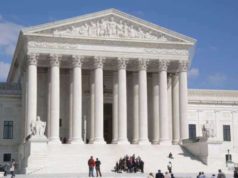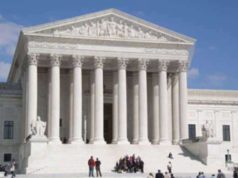
The United States Supreme Court is often described as the “least dangerous branch” of government, because it lacks the power of the purse (the ability to disburse funds) and the sword (the ability to enforce laws). However, it is still a powerful institution, and its rulings have far-reaching consequences for American law and society. One of the factors that can influence the Court’s decisions is the judicial leanings of its members. In this article, we will explore the various judicial leanings present on the Supreme Court and how they can affect the Court’s rulings.
Originalism
One of the most prominent judicial leanings on the Supreme Court is originalism. This is the belief that the Constitution should be interpreted based on its original meaning at the time it was written. Originalists see the Constitution as a fixed document that should be applied in the same way today as it was in the past. They favor a strict interpretation of the Constitution, and they tend to be skeptical of judicial activism.
Justice Antonin Scalia was one of the most prominent originalists on the Supreme Court. He believed that the Constitution should be interpreted according to its original meaning, and he argued that this approach was necessary to maintain the stability and predictability of American law. Scalia was often critical of his fellow justices for their willingness to engage in judicial activism, and he argued that the Supreme Court should defer to the democratic process and the elected branches of government whenever possible.
Today, Justice Clarence Thomas is often viewed as the leading originalist on the Court. Like Scalia, he believes that the Constitution should be interpreted based on its original meaning, and he is known for his strict adherence to legal precedent. He has been particularly vocal in his criticism of Roe v. Wade, the landmark Supreme Court case that legalized abortion nationwide.
Pragmatism
Another influential judicial leaning on the Supreme Court is pragmatism. This is the belief that the Constitution should be interpreted in a way that promotes practical outcomes and serves the interests of society. Pragmatists tend to be more flexible in their interpretation of the Constitution than originalists, and they are more open to engaging in judicial activism.
Justice Oliver Wendell Holmes was one of the earliest and most influential pragmatists on the Supreme Court. He believed that the law should be judged based on its ability to promote social progress, and he argued that legal decisions should be grounded in empirical evidence rather than abstract theories. Holmes was known for his willingness to challenge established legal doctrines, and he played a key role in shaping American jurisprudence in the early 20th century.
Today, Justice Stephen Breyer is often viewed as the leading pragmatist on the Supreme Court. He believes that the Constitution should be interpreted in light of changing social conditions, and he advocates for a more flexible approach to legal interpretation. Breyer is known for his willingness to engage in judicial activism, and he has written extensively on the need for judges to factor in the practical consequences of their decisions.
Textualism
Textualism is another important judicial leaning on the Supreme Court. This is the belief that legal texts should be interpreted based solely on their plain meaning, without regard to the intentions of the lawmakers who wrote them. Textualists tend to be skeptical of legislative history and other extrinsic evidence, and they focus on the text of the law as the sole guide to judicial interpretation.
Justice Scalia was also a prominent textualist on the Supreme Court. He argued that the words of a text should be read according to their ordinary meaning at the time they were written, and he claimed that this approach was necessary to prevent judges from applying their own subjective interpretations to legal texts. Scalia was often critical of his fellow justices for their willingness to rely on legislative history or other extrinsic evidence to interpret laws.
Today, Justice Neil Gorsuch is often seen as the leading textualist on the Supreme Court. He believes that judges should stick to the plain meaning of the text of the law, without regard to extrinsic factors or policy considerations. Gorsuch is known for his rigorous analysis of legal texts, and he is often critical of his fellow justices for departing from the plain meaning of the law.
Living Constitution
Finally, the “living Constitution” is another important judicial leaning on the Supreme Court. This is the belief that the Constitution is a dynamic document that must be interpreted in light of changing social conditions and evolving moral norms. Living constitutionalists tend to be more open to judicial activism than originalists, and they believe that the Court should play an active role in promoting social progress and protecting individual rights.
Justice William Brennan was one of the most influential living constitutionalists on the Supreme Court. He believed that the Constitution was a living document that should be interpreted in light of changing social conditions, and he advocated for a more activist role for the Court in shaping American law and society. Brennan was a strong advocate for individual rights and civil liberties, and he played a key role in expanding protections for free speech, freedom of religion, and the rights of criminal defendants.
Today, Justice Sonia Sotomayor is often seen as the leading living constitutionalist on the Supreme Court. She believes that the Constitution is a living document that should be interpreted in light of contemporary social conditions, and she is a strong advocate for individual rights and liberties. Sotomayor is known for her willingness to adopt a more activist approach to judicial interpretation, and she has been a vocal defender of the rights of minority groups and marginalized communities.
Conclusion
The Supreme Court is a complex institution, and the judicial leanings of its members can have a significant impact on American law and society. Originalism, pragmatism, textualism, and the living Constitution represent some of the most important judicial leanings on the Court, and they reflect a range of different approaches to legal interpretation and judicial activism. Understanding these judicial leanings can help us to better understand the Court and its rulings, and it can help us to appreciate the many factors that influence American law and jurisprudence.
As it is enacted by the Constitution, the Supreme Court, and the American judicial system as a whole can be interpreted in theory as the least politicized section of Government
and the one most purely given over to procedural, essentially technical
questions rather than ideological and philosophical ones.
A federal judge differs from members of Congress and the President in gaining his or her office through appointment rather than election, and in that way is secured against the shifting judgments of the electorate. Similarly, the right to a lifetime term enjoyed by members of the Supreme Court assures that their influence over the judicial system can outlast what are sometimes pictured as the essentially fickle currents of politics? In practice, however, the question of so-called judicial leanings of any given Federal judge has become increasingly urgent questions over the course of American history.
Today, political and legal commentators commonly assign Supreme Court members a place along a right-left political spectrum, and thus, assess their probable impact on the judicial system. In determining the ideological orientation of the Supreme Court as it is currently formed, the views of the individual members of the bench will be taken into account along with the ideology of the Chief Justice. While the the former question is commonly tracked in terms of a shifting balance of political power, as one Federal judge retires or dies and is replaced by another, the politics of a Chief Justice are often used to place an overall ideological stamp on a period.
The leanings of the American the judicial system in the post-World War II period, for instance, were typified by the readiness of the Warren (1953-1969) and Burger (1969-1986) courts to use the judicial system to accomplish liberal initiatives judged too contentious to enact through legislation, including Federal action against racial segregation and the availability of abortion. The Rehnquist (1986-2003) and Roberts (2003-present) courts, by contrast has been seen as more conservative in their judicial leanings and linked to the general rightward shift some commentators believe has occurred in American politics as a whole.
The specific nature of the duties required by the judicial system means that the liberalism or conservatism of any given Federal the judge will likely operate differently than it would in the legislative or executive branch. For all of the importance placed on the nomination or defeat of candidates for Federal Justice on the Supreme Court, Democrats and
Republicans do not formally endorse their favored choice. Though theoretical questions arising from the American judicial system may carry implications for the nation as a whole, they do not refer ultimately to the desires of interest groups or other common sources for legislative action, but rather than Constitutional interpretation.
In this sense, the ideological split in Supreme Court decisions, though present, has been generally observed to occur with far less consistency than is the case in Congressional votes. The question of the judicial leanings of a Federal judge in this sense can be a
the more nuanced question than it is in regard to legislators.



















